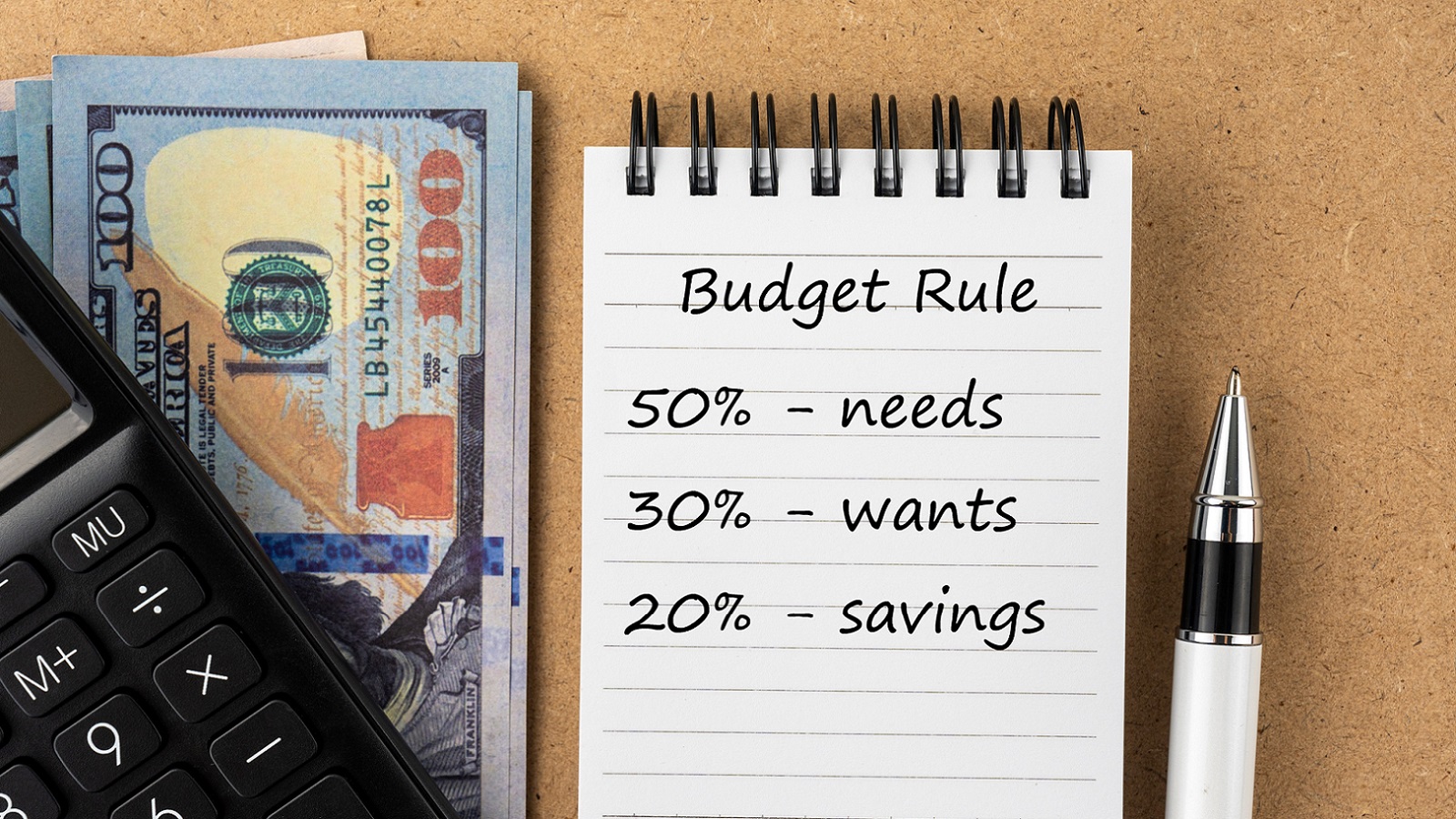The 50-30-20 Budget Rule: A Simple Way to Save Money
The 50-30-20 budget rule keeps budgeting simple. You'll prioritize savings while paying off debt, but is it right for you?


Looking for a straightforward budget that helps you save money and more effectively manage your finances? Consider the 50-30-20 budget rule. Created by U.S. Senator Elizabeth Warren in her book All Your Worth: The Ultimate Lifetime Money Plan, the 50-30-20 rule has been a gold standard for budgeting since 2006. This budgeting tactic can be a great first step for anyone looking to better manage their money, as it keeps things simple while helping you prioritize saving and paying off debt.
One major benefit of this plan is its flexibility. The rule can be adapted to best fit your household's particular needs. In fact, you may find that the 60/30/10 method may be a better fit for your household, given elevated costs on everything from housing to groceries.
The main takeaway of the 50-30-20 rule is that it helps you determine exactly where your money is going each month, which in turn helps you make changes in your spending. Here's what you need to know about the 50-30-20 budget rule.

Sign up for Kiplinger’s Free E-Newsletters
Profit and prosper with the best of expert advice on investing, taxes, retirement, personal finance and more - straight to your e-mail.
Profit and prosper with the best of expert advice - straight to your e-mail.
What is the 50-30-20 budget rule?
The 50-30-20 rule is a form of budgeting that splits your monthly, after-tax income into three major categories: necessities, wants and savings.
50% — necessities
When following the 50-30-20 budget, you'll start by allocating 50% of your income towards necessities. These are expenses that you just can't avoid, such as:
- Housing
- Utility bills
- Food
- Transportation
- Child care
- Insurance (car, home, life)
30% — wants
Let's face it, life would be miserable if you didn't have a few splurges every once in a while. Luckily, with the 50-30-20 budget, you'll allocate 30% of your take-home income towards wants. This category obviously includes all non-essential purchases, such as:
- Subscription streaming services, such as HBO Max or ESPN Plus
- Vacations
- Dining out
- Theatre, concerts, sports matches
- Leisure goods, luxury household items, apparel
20% — savings
Finally, the remaining 20% of your income should be put in savings, whether it's longer-term savings, like your retirement account, or for more short-term savings needs e.g. a rainy day fund, or to pay off any debt you have. While this section makes up the smallest portion of your overall income, it's the most important.
When adhering to the 50-30-20 rule, consider interest rates on any debt you may have. If interest rates on that debt are high, it's recommended to put all 20% towards paying off that particular debt. However, if the interest rates on your debt are fairly low, consider putting 10% towards savings and using the remaining 10% to make payments against debt.
In fact, you can search for the best savings rates below by using our tool, in partnership with Bankrate. Find the best rates from banks and credit unions that are FDIC or NCUA insured.
Example of a 50-30-20 budget
Here’s an example of budgeting using the 50-30-20 rule.
If you bring home $5,000 after-tax each month, according to the rule you'd split your income as follows:
- $2,500: 50% of your income, is allocated towards necessities — rent, utilities and groceries.
- $1,500: 30% of your income, is allocated towards things you want, whether it’s the latest iPhone or a fresh outfit.
- $1,000: 20% of your income, is set aside for saving or for paying off debts.
If you have low-interest debt, you might consider putting 10% ($500) towards an emergency fund and another 10% towards a personal loan.
The 60/30/10 rule
A flexible alternative to the traditional 50/30/20 rule is the 60/30/10 rule, which allocates 60% for essential expenses, 30% for discretionary spending and the final 10% for savings or paying down debt. This new model works better for a growing number of individuals who spend a higher portion of their monthly income on necessities.
And that number is growing. The number of cost-burdened (when a household has a cost ratio of over 30%) renter-occupied households was 20.1 million in 2021, according to the U.S. Census Bureau. That marks an increase of around 1 million households since 2019. Approximately 31% of all households are spending 30% or more of their income on housing alone, according to USAFacts.
However, since only 10% is budgeted towards savings or paying down debt with this rule, individuals should be more mindful of their discretionary spending, looking for additional savings opportunities where they can.
Bottom line on the 50-30-20 rule
Overall, the 50-30-20 rule is a simple guideline for budgeting. However, it may not be the right fit for everyone’s financial situation. For example, you may have a lot of expenses each month that take up more than 50% of your monthly income, leaving little to allocate towards wants or savings. On the other hand, it can be a useful framework for individuals who prefer a structured, straightforward approach to budgeting.
Related Content
Get Kiplinger Today newsletter — free
Profit and prosper with the best of Kiplinger's advice on investing, taxes, retirement, personal finance and much more. Delivered daily. Enter your email in the box and click Sign Me Up.

Erin pairs personal experience with research and is passionate about sharing personal finance advice with others. Previously, she was a freelancer focusing on the credit card side of finance, but has branched out since then to cover other aspects of personal finance. Erin is well-versed in traditional media with reporting, interviewing and research, as well as using graphic design and video and audio storytelling to share with her readers.
-
 What 401(k) Savers Near Retirement Can Do Amid Market Volatility
What 401(k) Savers Near Retirement Can Do Amid Market VolatilityWhether retirement is years away, a year or two out, or in the rearview mirror, here's how to handle uncertainty in your 401(k).
By Donna Fuscaldo Published
-
 The New Space Age Takes Off
The New Space Age Takes OffThe Kiplinger Letter From fast broadband to SOS texting, space has never been more embedded in peoples’ lives. The future is even more exciting for rockets, satellites and emerging space tech.
By John Miley Published
-
 What Does Medicare Not Cover? Eight Things You Should Know
What Does Medicare Not Cover? Eight Things You Should KnowHealthy Living on a Budget Medicare Part A and Part B leave gaps in your healthcare coverage. But Medicare Advantage has problems, too.
By Donna LeValley Published
-
 How Our Family Fights Inflation
How Our Family Fights InflationBudgeting Millennials typically spend more than other generations on certain expenses that have been increasing most rapidly. Here are some tips to cut your losses.
By Lisa Gerstner Last updated
-
 Gas Prices Around the World
Gas Prices Around the WorldBudgeting Many world gas prices can make what Americans pay at the pump seem like a bargain. But not all.
By David Muhlbaum Last updated
-
 What You Can Do About Medical Debt
What You Can Do About Medical DebtBudgeting Millions of Americans are awash in debt from medical care. If you’re one of them, we have your options, whether the bills are new or a collector is calling.
By Elaine Silvestrini Published
-
 What to Do When You Can’t Pay Holiday Debt
What to Do When You Can’t Pay Holiday DebtBudgeting More Americans borrowed money to pay for holiday purchases and now the bill is due. Balance transfer cards offer a reprieve.
By Elaine Silvestrini Published
-
 Is Budgeting Overrated?
Is Budgeting Overrated?Budgeting Take it from a financial planner, not everyone needs a budget. In fact, sometimes a budget can distract you from the real solutions to your financial problems.
By Matt J. Goren, Ph.D., CFP® Published
-
 Make a Plan to Start Repaying Student Loans
Make a Plan to Start Repaying Student LoansPaying for College The pandemic-era pause on student loan repayments is scheduled to end September 30. If you can’t afford payments, you have options.
By Emma Patch Published
-
 15 Best Things to Buy at Dollar Stores (Dollar Tree Included)
15 Best Things to Buy at Dollar Stores (Dollar Tree Included)You might be surprised by some of the items you can and should purchase for just a buck.
By Bob Niedt Last updated